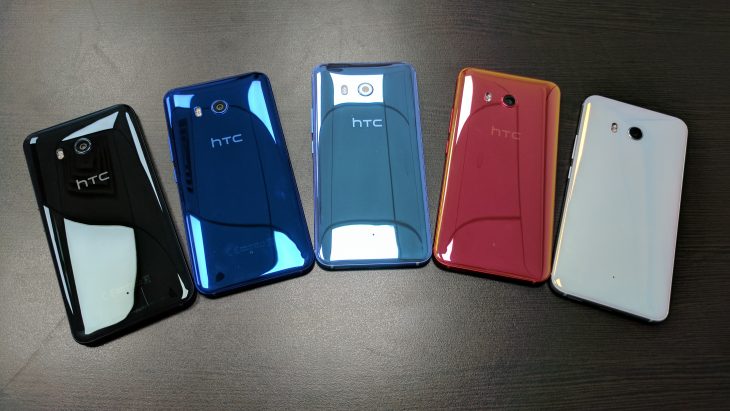
We’re in Taipei at HTC’s headquarters for the launch of the U11, the company’s 2017 entry into the smartphone flagship wars. This is ground zero for HTC, which celebrated its 20th birthday just hours before.
The U11 is the company’s latest and greatest device, but it’s also particularly important for the company. HTC needs a hit, and we’d really like to see the U11 hit it out of the park.
HTC’s bringing its A-game. The U11 screams 2017 with a bleeding edge processor, a big 5.5-inch screen, class-leading camera and the latest enhancements to the company’s USonic USB-C-powered headphones. It moves the needle in every place it needs to, and we’re expecting it to make waves when it’s released soon.
Can HTC pull a rabbit out of its hat and bring us 2017’s next great phone? Signs are good. Right now though, we just can’t look past the gorgeous new red and silver colours on display.
Read on to find out why this phone is sending ripples of excitement around the Ausdroid office.

Let’s not bury the lead here, though – HTC’s been teasing “Squeeze the Brilliant U” for a few weeks now, bringing the company’s 2017 message – that its phones are all about “U” – while also teasing focus on a new way to interact with your phone – squeezing it.
Squeezing The Brilliant U
As rumoured, the U11’s big party piece is the addition of squeeze-sensitive edges on the phone. It’s called Edge Sense and it allows the phone to take actions based on a single, double or long squeeze of the lower edges of the phone (the part under the power button).
What can you do with Edge Sense? Well, that’s really up to “U”. It could launch the camera, activate the phone’s flashlight feature, open the Google Assistant. It can switch your keyboard to voice input, or take you to an app – or maybe just your settings.
Edge Sense is highly contextual – it can do different things with different presses in different apps. The sides of the display indicate the phone detecting your squeeze, and a satisfying vibration gives you the feedback you need to tell when your squeeze has been registered. You can also customise how hard you need to squeeze. All of this makes your phone intensely yours.

HTC is promising an SDK for app developers, and an Amazon Echo-like “skills marketplace” for users where they can bake and upload their own recipes for using Edge Sense in other apps.
The U11 would be a pretty awesome phone even without Edge Sense, though.
Striking Exterior
First, let’s look at the exterior. Make no mistake, this phone is gorgeous.
The U11 marks the second outing for HTC’s Liquid Surface glass rear with five colours coming to market this time around. There’s the return of the classics – black and white – with the amazing blue first seen on the U Ultra and U Play earlier this year too, but the addition of absolutely striking red and silver editions.
These new colours are going to be the ones you’ll look out for when you’re out to pick up the U11. Hopefully they’ll all make it to Australia, but we’ll have to prepare ourselves for the possibility that they won’t.
Besides the new colours, HTC’s enhanced its Liquid Surface production process as well. Each base colour now reflects some new spectrum under the right light, as if the glass were a fabric shot with a secondary colour. Red becomes gold in the right light, while Silver takes on a brilliant bright blue. Black refracts some new green, and the amazing blue we saw in the Ultra takes on some new purple reflections.


The glass extends just around to the front of the phone – still clad all in black glass – and provides a fantastic in-hand feel with lovely rounded edges. It brings a great look to the phone when viewed at the slightest of angles as it envelops the front.
In a first for HTC, this year’s flagship is finally getting an official IP rating (IP67). Like most water resistance ratings, its for fresh water over salt, and the company points to the fact that the phone’s squeeze interaction allows it to actually take the phone underwater and take a photo, something you couldn’t do before (well, without modifying the camera app configuration to use volume keys). It’s built in the to
Elsewhere on the U11 we’ve got a greatly reduced camera bump and little else on the rear, while the combined home button / fingerprint sensor below the screen on the front of the phone is flanked by capacitive input keys. HTC’s gone for standard Android controls this time around too, with a back button to the left and the recent apps button right.
The 5.5-inch QHD display does make the phone bigger than others in its class in both width and height. HTC hasn’t followed Samsung and LG in reducing the top/bottom bezels to squeeze in a different aspect screen. This is really a case of not-broke-don’t-fix, and that screen is of course a HTC standard Super LCD screen that favours true-to-life colour reproduction over hyper-saturated sensory overload.
You can see the size in comparison to a Galaxy S7 below:

Class Leading Internals
Exterior design is all well and good, but we know that the internals are going to make or break a flagship-class phone. HTC has a well established reputation for not compromising on specs, and the U11 is no different.
The U11 moves the needle where it matters with notable enhancements to performance, camera and audio.
First up, we’ve heard much about issues getting Qualcomm’s Snapdragon 835 to market, especially with HTC’s comments on holding off until the components are available. We’re glad they did, with company throwing out some impressive numbers as benefits brought about in performance from Qualcomm’s latest silicon. The short version is this: Better performance, with better battery life.
HTC’s not shy about taking some digs at other manufacturers too, proudly reminding us all that all phones ship with the same components in them, worldwide – there’s no per-territory processor switching going on here, and no lucky draw on components inside your U11. Everyone’s a first-class citizen.
On the camera front, HTC’s coming off a world-leading performance enjoying the spotlight cast on it from the high DXOMark score for 2016’s Google Pixel and its own HTC 10. The company’s been coy with us about the actual score in the leadup to today’s event, but has drawn our attention to a number of key features.
First of all, the camera calls to mind HTC’s past success in its name – UltraPixel 3. That calls out low light performance right there.
In terms of raw specs we’re looking at a 12MP rear camera with 1.4um pixels tied to an f/1.7 aperture with 5-axis Optical Image Stabilisation (OIS) for still images and software Electronic Image Stabilisation (EIS, similar to that seen in the Pixel) for video. It’ll handle 4K video, and 24bit high res audio recording.
The sensor supports full-sensor Phase Detection Auto Focus (PDAF), allowing it to focus quickly and snap instantly. The company’s calling this Ultraspeed Autofocus.
HTC’s HDR shooting modes have sometimes come off second best in comparative shootouts, owing to a tendency to overexpose. No more – the company’s paying special attention to the feature this time around, enhancing it into their own HDR Boost feature which will be on by default, and operate with no lag. Combined with OIS and PDAF, this should make the U11 a low-light powerhouse.
Another camera spec that’s certainly welcome but not often mentioned is a wide angle of shooting – 150 degrees in the U11’s case. It’s pretty amazing to hold a camera in your hand that captures so much of the view around you when just a couple of years ago far lower angles were the norm.
Finally, with the phone’s 4 omnidirectional microphones, it can perform acoustic focus; when you zoom in on a subject you’ll hear them above other background noise. It’s a subtle change but can drastically improve audio production in noisy environments. It’s from here that we get the rumoured 3D audio recording feature, allowing you to record moments as you hear them.
With this in mind, it’s not too surprising to hear the DXOMark score for the U11’s camera is 90, topping the Pixel’s score by that one coveted point. While we’ve taken issue with DXOMark scores vs real world performance in the past, the fact remains that the U11 certainly has everything it needs to perform on paper. We can’t wait to put the camera through its paces.
Don’t forget the front camera, too – it’s a 16MP model with f/2.0 aperture. HTC’s saying it’s got the same HDR Boost functionality as the rear camera and is also bringing its UltraPixel-ish low light sensitivity to the fore in a neat blend of the technologies. It’s sure to up your selfie game.
Bringing the Boom to USonic
HTC has a rich legacy in audio, so its no surprise to see the U11 pushing forward in some major ways.
The company flirted with nerd outrage already this year, removing the 3.5mm headphone jack from the U Ultra and U Play and shipping USB-C headphones instead, powered by its nascent USonic system.
The big failure there was the lack of adapter to connect headphones with cables to the phone’s relatively new USB-C port, something the company has learned from – this time out, there’s a USB-C-to-3.5m adapter shipped in the box with its own high-performance DAC included. It’s not just compatible with the U11, either – HTC says it’ll work with a number of other phones, and it’s been engineered for life, and is rated to survive 10,000 bends and 10,000 plug/unplug cycles.

Beyond that, HTCs also enhanced the in-box headphones. For most manufacturers, these are a bit of an afterthought and rarely provide much in the way of audio qualiy. Not so here – the U11’s USB-C headphones support active noise cancelling and it makes a noticeable difference when its activated. This functionality is actually brought about by the USB-C connection and uses the phone’s processor to calculate the noise cancellation – we’ll have to wait and see how well it works if plugged into another device.
Delving even further, the company’s USonic system still uses sonar principles to learn your ear canal structure and adapt the audio produced by the phone to better suit your own ears. Calibration is much faster this time around though. Combined with the active noise cancelling, HTC is again making the U11 your phone.

Finally, HTC’s BoomSound pedigree stands it in good stead for speaker performance and it makes a return in Hi-Fi Edition, a reworking of the BoomSound ideas that separates responsibility for the woofer and tweeter and places them at opposite ends of the phone. HTC says its new BoomSound uses the phone’s whole body as an acoustic chamber, taking advantage of everything between the bottom-firing speakers and the earpiece. Placed next to 2016’s HTC 10, it’s amazing the difference in sound volume and quality, with minimal distortion even as the volume is pumped up. The U11 can replace small portable bluetooth speakers.
The Software Front
The U11 samples we’ve been shown are running Android 7.1, one of the only phones in the market to have it. It’s a fairly stock-ish distribution, with no obvious messing about done to the notification system or system settings, save the addition of new settings panels to accomodate HTC’s own features.
When queried about the forthcoming Android O (expected to be officially named at Google I/O this week), HTC’s representatives coyly told us that they would definitely not leave their flagship phone behind on updates. Translation – you can expect Android O after Google releases it to the world, and with this week’s announcement of Project Treble we’re hoping to see these updates quicker in the future.
HTC’s entry in the AI stakes – Sense Companion – makes a return in the U11. It’s still got the same helpful features we saw in the U Ultra and U Play, but HTC’s looking to add more smarts to it in the next few months including weather, restaurant recommendations and more.
The U11 is also shipping with two voice assistants built in – Google Assistant, and Amazon Alexa. The Snapdragon 835 allows HTC to use multiple Wake Words and fire up the assistant the user requested. Alexa won’t be too useful in Australia given our lack of Amazon services, but it’ll be delivered via an update in the Play Store to customers in the US, UK and Germany within 30 days of launch.
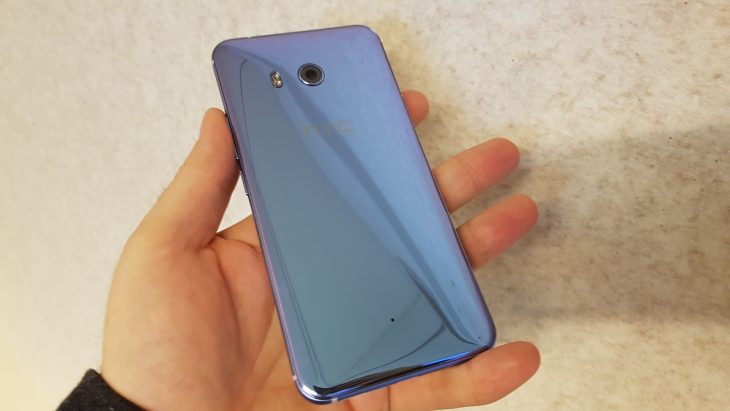
Australia will be getting the 4GB RAM model that features 64GB of onboard storage. MicroSD is also supported, bringing the theoretical maximum storage on the phone to over 2TB (if you can find the Micro SD card, HTC will support it). We’re also getting the single-SIM model. None of this is earth-shattering news, though worse would be if HTC was unable to bring their amazing new colours to market here.
HTC’s not ready to divulge Australian pricing and availability for the U11 yet – we’re expecting to hear about this next week, with wide ditribution in June.
With the U Play and U Ultra recently taking steps down the pricing ladder, there’s little doubt where in the range the U11 will sit, although the rumoured Taiwan price of ~US$650 gives us some hope that we’re not looking at a $1000+ handset here. Bringing the U11 to Australia under that price would be a smart move to grab some attention and mindshare. We’re hopeful you’ll see the phone in carrier stores and retailers locally and will update as we near the local launch.
If you want to know more about the U11, including a first-hand look at HTC’s shiny new flagship, check out Ausdroid’s Facebook Live stream from the hands-on area. Go to the Ausdroid Facebook Page to find the post.
Official Pics
These renders and press photos really don’t do the phones justice, but we’re including them here for completeness anyway.
Amazing Silver
Brilliant Black
Ice White
Sapphire Blue
Solar Red
Jason travelled to Taipei as a guest of HTC to attend this launch event.


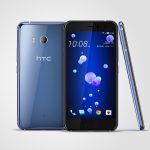

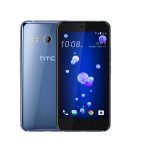

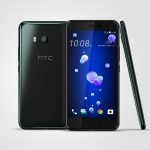



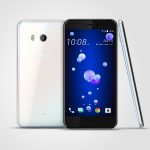
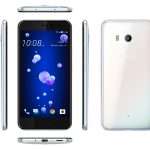
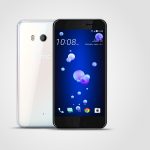
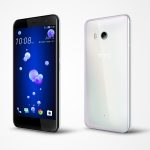

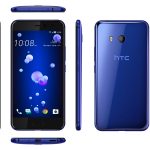
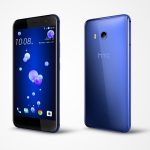

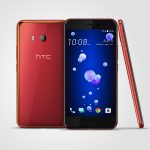
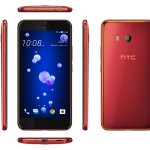

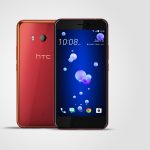



Any news on carriers?
We’re expecting to hear about pricing and carriers in the next week or two.
The Snapdragon 835 supports Bluetooth 5, but the HTC U11 only has Bluetooth 4.2. They both use the same frequencies so the same antenna should work for either.
Does anyone know why the HTC U11 is lacking Bluetooth 5?
Same question. I thought HTC got the phone certified too? See: https://www.bluetooth.org/tpg/QLI_viewQDL.cfm?qid=34462
HTC confirms it’s certified for 4.2; I’ve asked if they’re planning to go for BT5.
And what does Bluetooth 5 do that the previous don’t?
Twice as fast, 800% larger broadcast size, larger range. Most important part is Lossless audio for those who are so adamant that they need a 3.5mm jack to get the best audio quality to their headphones.
Too bad HTC (and third party Android OEMs in general – Blackberry being the only exception I can think of off the bat) are rather poor when it comes to security updates. They’re the ones that really matter.
EDIT: The lack of headphone jack is also going to ruffle more than a few feathers.